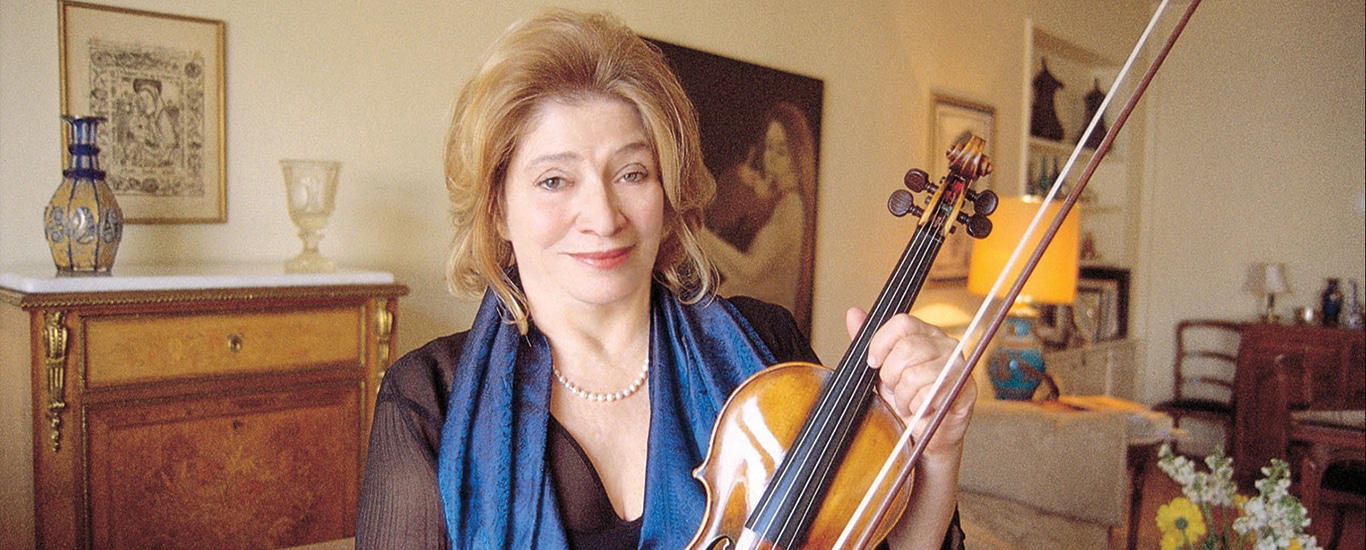A fight breaks out over Mahler’s First
mainBreitkopf has brought out an edition of Mahler’s first symphony based on Erwin Stein’s 1960 version, which includes the discarded Blumine movement.
Nothing wrong with that, though personally I wouldn’t bother with the Blumine bits.
Universal Edition, however, have reacted with fear and loathing. They flew Marina Mahler, the composer’s granddaughter, to the Frankfurt Music Fair yesterday and got her to declare that anyone who does not use the Universal edition is acting ‘against the will of Gustav Mahler’.
The Internationale Gustav Mahler Gesellschaft has also been wheeled out to trumpet the ‘scientific accuracy’ of the Universal score.
Those boys and girls need to calm down.
Read what Mahler said and did about the first symphony, then make up your own minds.
(Hint: it’s all in Why Mahler?)

Marina yesterday at the Frankfurter Musikmesse
photo (c) Universal Edition






It is strange that some people are still bent on including the
Blumine movement as part of this symphony, when Mahler himself wisely discarded it. It is not even such a great piece. I haven’t seen anyone trying , for example, to re-install Beethoven’s Gross Fugue back in to Op. 130 Quartet, even though it is by contrast a monumental masterpiece.
The fugue is often included in performances of the quartet. I’ve seen it a number of times.
Happens occasionally both on records and live with Op. 130/133, I assure you.
Strange as well that some insist on still performing the 6th in Scherzo-Andante order rather than Andante-Scherzo; but pretending there is some alleged “uncertainty” about Mahler’s final decisions about various aspect for some symphonies provides a justification for certain scholars and performers to gin up controversy and interest – and lucrative markets, of course.
As for the Grosse Fuge, it seems quite common in performances I’ve seen and recordings I’ve heard to use it as the finale to the Op. 130 Quartet (and most CDs include perfomances of both the official finale and the fugue, which then can be programmed however the listener prefers). I think the issue with regard to the fugue’s status is a different one to the issue of performing Mahler’s 6th in the clearly erroneous S-A order.
There’s no pretending. There was a musicologist and friend of Mahler who claimed that the Vienna performance – the last one conducted by Mahler – had been performed in S/A order. Everybody ignores that. Also, a critic was greatly confused and wrote in his review, “the second movement is the third movement, because the third movement is the second movement” (something like that). Mahler had intended to revise the 6th yet again, and he never did say anything definitive on movement order to anyone. In fact, he never did say much of anything definitive about the sixth at all. Also, why assume that Alma stated S/A to Mengelberg for her own selfish reasons? Clearly there was still uncertainty at the time Mahler died. Further more – and this is the most important point of all – many conductors still use S/A because musically it works better, certainly in terms of key relationships. When I saw Bychkov do Mahler 6 with the Vienna Phil. in Berkeley, he was going to perform it in andante/scherzo order. At the last rehearsal, he changed his mind for purely musical reasons.
I’d say also that, even if the very detailed article published by the Kaplan foundation about the “correct” movement order in the Sixth symphony shows that Mahler performed Andante then Scherzo, I did change my mind rapidly after believing that these conclusions should be adopted : In fact, Mahler COMPOSED the music in the other way (scherzo then andante), and the switching of movements seems to have been dictated bt his fear that having the crazy scherzo after the massive first movement would be “too much” for the audience. But nowadays the audience is ready for that ! and, As as been pointed out already, the tonalities of the end and begining of the movements flow into each other when performed in the order the music was composed.
So, the choice here seems to be “perform like Mahler did (order-wise) for whaterever reasons” or “perform like he originally intended, when the music was still only a creation in his mind”. There are only good reasons for each one, personally the second option has my vote now, also because unlike the scherzo-andante order, the first movt-andante-scherzo-last mvt order induces awkward tonalities transitions. I feel that Mahler had to make a choice, a compromise, and that the compromise modern performers have to choose today can be different.
Much ado ’bout nothin’. With or without “Blumine”, it’s still a pretty darn good first symphony by anybody’s standard.
I’ll be more inclined to listen to Universal when they remove the glaring mistakes from the piano score of Das Lied von der Erde instead of just taking the money and running.
I agree with Marina Mahler! My feeling is that including the Blumine movement is making a huge mistake as I don’t think the personality of that movement fits in with the rest of the symphony.
I read “Why Mahler?” Shortly after it was published and enjoyed it very much.
It seems that Breitkopf makes money with an old UE-score …
That‘s not true. Breitkopf just presented a whole new scholarly edition, and the „Blumine“ is not even included in the symphonie‘s corpus but only printed in the appendix!
I agree that Blumine is not very good, but the original version is interesting because it has slightly more relevance to Jean Paul’s Titan. The novel is hugely enjoyable once you get into it, and a parody of romantic themes. I suspect Mahler was uncomfortable about the association of doppelgänger and a suicidal poet, whose play is a device in which he can commit suicide in public. In my over romantic mind I see it as an echo of Mahler’s relationship with Rott. Guilt? jealousy?
I hardly think the reaction amounts to ‘fear and loathing’. They just want to protect their edition. As for the ‘acting against the will of Gustav Mahler’, was he some sort of god? He composed the thing in the first place. All a fuss about nothing. Musicians can make up they rown mind.
When Breitkopf publishes a version from 1960, then they neglect all musicological results since that time. Or does Breitkopf have all the sources?
“When Breitkopf publishes a version from 1960, then they neglect all musicological results since that time. Or does Breitkopf have all the sources?”
You’re implying that “they neglect all musicological results since that time” and that they don’t have “all the sources” while saying that you don’t have any sources about there sources by asking that question. That’s… something?
@Norman Lebrecht:
Would you please correct “…about *their* sources”?
Thank you!
2 points here. 1 – Blumine does not belong to the standard version of the symphony since Mahler himself removed it before he revised the score and enlarged the orchestration. 2 – there is a Critical Edition by UE from 1992 which supersedes the Erwin Stein version and I would supposed those revisions are still under copyright. Supposedly some revisions have been made by Breitkopf, but one wonders how accurate it all is.
“2 points here.”
Nice try! 😀
“but one wonders how accurate it all is.”
That’s true for every single (critical) edition, not only Breitkopf. It should always be as accurate as possible, that goes without saying. But sometimes there’s an area of discretion, where decisions can go both ways. Each of these decision (and pretty much everything else) should be explained in the critical report. There you can agree with it or not (and thus being subjected to other people’s wonder, too).
In other words, there’s a margin of error. And it doesn’t matter, who made the edition, because that margin of error stays the same.
There is much more to this question than can be discerned here or in NL’s book. I most highly recommend Jeffrey Gantz’s lengthy article, “Missing Movement? The Provenance of Blumine in Mahler’s First Symphony”. It is in an internet archive and so easily found online. Enlightening on many points. Britten conducted the symphony with Blumine included in 1967 — I’d give much to know his reasoning. That may have been set down somewhere, but I haven’t yet found such beyond passing mentions. I must wonder if Donald Mitchell, Mahler scholar and Britten devotee, played a part in that.
The fact is that later parts of the symphony have reminiscences of the “Blumine”, so if you take it away, they are reminiscences of an absence, as if the symphony has had a frontal lobotomy. But with the changed orchestration, there is no longer any good solution. As with the Sixth, it is Mahler’s fault for never being able to make up his mind before bequeathing the whole conundrum to posterity.
You nailed it.
This is what I was going to point out. If Mahler had lived longer and heard his work performed more maybe he would have put Blumine back with some revisions. I don’t think there is an ideal solution without inventing a time machine and going back to get Mahler’s input. And while we’re doing that lets get him to finish the tenth too!
Could you provide a link to the article? Thanks…
While it is not quite clear from Donald Mitchell’s comment in “The Wunderhorn Years” p219, I read it that Britten performed only the Blumine movement at Aldeburgh in 1967, not the whole symphony.
N. L. : “Breitkopf has brought out an edition of Mahler’s first symphony based on Erwin Stein’s 1960 version, which includes the discarded Blumine movement.”
Erwin Stein, who died in 1958, arranged Mahler’s First for reduced numbers of wind instruments. This arrangement was published by UE in 1967. Upon which Stein version did Breitkopf base its new edition?
I can’t imagine any serious critical edition of Symphony 1 that didn’t include ‘Blumine’ as an appendix.
I have no objection to a truly source-critical edition of Blumine or of even hearing it in performance–but only in the context of the original 1889 Mahler 1st score, which not only contained Blumine but also contains sometimes substantial differences in the other movements. In the 1889 version inclusion of Blumine might make much more sense, in light both of the differences in orchestration and of the musical contents and structure of the Finale (see “The 1889 Version of Mahler’s First Symphony: A New Manuscript Source,” by Stephen McClatchie in the Autumn 1996 issue of 19th-Century Music available at JSTOR). The Breitkopf Mahler symphony Urtext series, as described by the publisher in its promo brochure (available at its website) and of which the 1st Symphony is apparently the first to reach print, won’t contain an 1889 Mahler 1st. You’ll have to get that from Universal if and when they get around to it.
The International Gustav Mahler Society (IGMG, gustav-mahler.org) has a few choice words at their site about the Breitkopf endeavor: “We would like to point out that the planned publication by Breitkopf & Härtel is not being undertaken with the cooperation with the IGMG and apparently does not meet the requirements of a modern scholarly, critical edition. . . . the approach of the publisher Breitkopf & Härtel seems to be to reproduce the old complete edition [originally issued by the IGMG] using computer engraving, but apparently without systematic research using all of the now available source material. This project is not coordinated with the IGMG: The IGMG cannot endorse the simple adoption of its now outdated research, and expressly distances itself from all such endeavors.”
I could see including Blumine as an Appendix to the score, simply on the basis of having more information about Mahler’s process in composing the piece. On the other hand, including it among the other movements is pretty objectionable, not only because he clearly cut it from the piece, but because its quality is so inferior to the rest of the symphony.
Given that the Grosse Fuge was the original Finale for Op. 130 AND the fact that it was apparently cut purely for commercial reasons at the suggestion of his publisher Artaria, you can make a case for including it in performances of the quartet on the basis of it being part of his organic conception of the piece.
In terms of Mahler 6 and the order of the middle movements, the evidence is clear that his last word on the matter was that the order should be Andante-Scherzo. Nonetheless, I find this order problematic, as it backloads the dramatic narrative to such an extent that the piece has never made sense to me that way. I don’t think it’s far-fetched to think that since he originally conceived of the piece with the Scherzo-Andante order, there’s an aspect of that order that’s hard-wired into the piece.
And while it’s easy to assert that Mahler knew what he wanted when it came to his music, his constant revisions to his pieces – to an extent that drove his publishers crazy – demonstrate that this wasn’t the case. Going against a composer’s wishes should be an EXTREMELY rare exception, but there are situations in which there’s some gray area.
What a terrible conundrum. The only way to solve this is to buy NLs book. So kind of him to point this out.
Who says the edition is based on Erwin Stein? It’s not Breitkopf & Härtel. They published a new score edited by Christian Rudolf Riedel of the 1st Symphony and a separate edition by Riedel of the Blumine. That’s all and that’s fine.
If you want to learn more about Mahler and some editorial issues of this symphony it doesn’t help to read the mentioned book above…
I found it rather disturbing, that obviously neither one of you guys had the chance of taking a look at the new Breitkopf edition. I just purchased it and got it by mail yesterday. Breitkopf‘s approach is flawless and justified. Their editor Christian Rudolf Riedel (by the way: a distinguished researcher) has edited a „version of the last hand“ as Mahler performed it in 1910. The „Blumine“ movement is in the appendix. For me it’s a masterpiece in the considerable row of Mahler scores. It‘s just not by UE but from a publisher who’s been around for 300 years. Period.
I would encourage readers to have a look at this blog post on the new research regarding the movement order of Mahler 1.
New Critical Edition of Mahler 1 reveals musicians have been playing the wrong movements in the wrong order
https://kennethwoods.net/blog1/2019/04/01/new-edition-of-mahler-1-reveals-musicians-have-been-playing-the-wrong-movements-in-the-wrong-order/
The granddaughter‘s POV might be clouded by residuals that any new version throws off. Musically and historically whatever version Michael Tilson Thomas decides to perform should be considered definitive.
The only ‘correct’ approach to me, when taking into account all the research done in the last century, would be to insist on differentiating between
1) what became the 1st symphony, in 4 movements
2) what was “Titan”, and included the Blumine movements.
I feel that some earlier attempts at making the Bumine movement heard and known, sometimes confused the audience and didn’t help the more serious ‘scholar’ approach. For example, CD releases of the symphony (in its final version), with the original Blumine just insterted ‘where it should have been’, with no consideration with the fact that the other movements were different (orchestration etc) at the time the music included this movement.
Another and more frequent ‘error’ is when a performance (or recording) of the 1st Symphony is advertised as “Titan”, when of course it is not the ‘Tone Poem in Symphony Form’ in two parts and five movements. That clearly doesn’t help the audience to know the music and/or what they’re going to hear.
Of course the people interested in the compositionnal history of the symphony should read – if not done alreaday, since it dates from more than twenty years ago ! – the article “The 1889 Version of Mahler’s First Symphony: A New Manuscript Source” by Stephen McClatchie [19th-Century Music Vol. 20, No. 2, Special Mahler Issue (Autumn, 1996), pp. 99-124]
On a footnote, I can only point interested readers to the 1894 Weimar version of Titan, which has been released by the French orchestra Les Siècles (on period instruments) led by their director François-Xavier Roth : https://lessiecles.com/actualite/disque-titan/
another useful links for Mahler geeks : Paul Banks “The Music of Gustav Mahler: A Catalogue of Manuscript and Printed Sources”
http://mahlercat.org.uk/
From the already mentioned Paul Banks website, the article about the double bass solo is of particular interest : https://www.mahlercat.org.uk/Pages/Symph1/Symph1db.htm